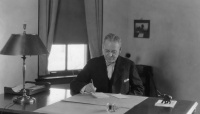L. W. Rogers Building
History
In 1925 the American Theosophical Society, now known as the Theosophical Society in America, purchased land in Wheaton, Illinois for a new headquarters campus. The Board of Directors approached architect Claude Bragdon, a prominent member of the Society, to design a building to serve as headquarters. Bragdon was then closing down his architectural practice to begin a career in theatrical design, and recommended a Chicago architect, Irving Kane Pond, of Pond & Pond, Martin & Lloyd, to take on the project. The architectural firm submitted two designs, and the Board could not decide between them, so President L. W. Rogers sent the drawings to Bragdon for review. Bragdon wired back that he preferred the asymmetrical design by Irving Pond over a symmetrical rendering by one of his partners.
Construction
Construction began in 1926, and the cornerstone was laid on August 29th in a Co-Masonic ceremony led by Annie Besant. The event was heavily covered by the Chicago Tribune and other newspapers, and people came by the hundreds on the interurban trains from Chicago to be present.
George S. Arundale at building dedication, August, 1927. Image from TSA Archives.
A dedication ceremony was conducted by the international president of the Theosophical Society, George S. Arundale in August 1927, and in September the staff moved the offices from Chicago.
In 1932, the headquarters estate was named "Olcott" in honor of President-Founder Henry Steel Olcott.
Architecture
The architecture of Irving Kane Pond is difficult to classify, but the Rogers Building is considered to fall into the Collegiate Gothic style, with interiors influenced by the Arts and Crafts Movement. The
Lobby
Offices
Meditation room
The meditation room is a serene space used only for meditation or meditation classes. Staff members gather every morning at 8:30 for 15 minutes for a group practice, and a healing group meets each Wednesday evening. Beautiful art works and oriental carpets line the room, including a thanka presented by the Dalai Lama in 1981 and a painting of Helena Petrovna Blavatsky by Gutzon Borglum, sculptor of Mount Rushmore. Just outside the doors of the meditation room are two pastels by Theosophist Burton Callicott They are Mandorla and Antahkarana
Library
The Henry S. Olcott Memorial Library, formerly known as the Olcott Library and Research Center, is a beautiful space that is used for meetings and performances as well as traditional library activities.
The library was expanded in 1964 to add space on three levels. The architect was Lillian Leenhouts of
Auditorium
The third-floor auditorium is used for lectures, workshops, yoga classes, conferences, and numerous other activities throughout the year. The space was remodeled in 2009, benefiting from the Bland administration's Capital Funds Campaign. A column was removed to improve sight-lines for the audience. The sub-floor was rebuilt and new carpeting was installed. Co-Masons donated a beautiful door and door frame featuring stained glass with the Society's emblem etched into it. New audiovisual equipment was installed to support Webcasts and recording of programs.
Art gallery
The anteroom to the auditorium is an art gallery with exhibits changed every 6-8 weeks.
Dining room
In 2010, the basement kitchen and dining area were extensively remodeled. The dining room was renamed Nicholson Hall in honor of the Nicholson family whose generous donation made the renovation possible.
